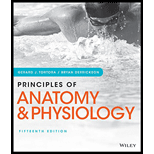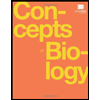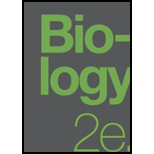
Principles of Anatomy and Physiology
15th Edition
ISBN: 9781119329398
Author: Gerard J Tortora, Bryan Derrickson
Publisher: John Wiley & Sons Inc
expand_more
expand_more
format_list_bulleted
Concept explainers
Textbook Question
Chapter 3, Problem 29CP
Outline the major events of each stage of the mitotic phase of the cell cycle.
Expert Solution & Answer
Want to see the full answer?
Check out a sample textbook solution
Students have asked these similar questions
List the phases of the cell cycle and describe the key events of each phase.
Describe the cell cycle and explain the major events thatoccur during each stage
Define the Mitotic Stage in the cell cycle ?
Chapter 3 Solutions
Principles of Anatomy and Physiology
Ch. 3 - Prob. 1CPCh. 3 - Checkpoint 2:
How do hydrophobic and hydrophilic...Ch. 3 - What substances can and cannot diffuse through the...Ch. 3 - “The proteins present in a plasma membrane...Ch. 3 - Checkpoint 5:
How does cholesterol affect membrane...Ch. 3 - Checkpoint 6:
Why are membranes said to have...Ch. 3 - Checkpoint 7:
What factors contribute to an...Ch. 3 - Checkpoint 8:
What factors can increase the rate...Ch. 3 - Checkpoint 9:
How does simple diffusion compare...Ch. 3 - Prob. 10CP
Ch. 3 - Distinguish among isotonic, hypotonic, and...Ch. 3 - What is the key difference between passive and...Ch. 3 - Checkpoint 13:
How do symporters and antiporters...Ch. 3 - What are the sources of cellular energy for active...Ch. 3 - Checkpoint 15:
In what ways are endocytosis and...Ch. 3 - What are some of the chemicals present in cytosol?Ch. 3 - What is the function of cytosol?Ch. 3 - Define an organelle.Ch. 3 - Which organelles are surrounded by a membrane and...Ch. 3 - Checkpoint 20:
Which organelles contribute to...Ch. 3 - Checkpoint 21:
What happens on the cristae and in...Ch. 3 - Checkpoint 22:
How do large particles enter and...Ch. 3 - Where are ribosomes produced?Ch. 3 - Checkpoint 24:
How is DNA packed in the...Ch. 3 - Checkpoint 25:
What is meant by the term gene...Ch. 3 - What is the difference between transcription and...Ch. 3 - Distinguish between somatic and reproductive cell...Ch. 3 - What is the significance of interphase?Ch. 3 - Outline the major events of each stage of the...Ch. 3 - Prob. 30CPCh. 3 - How are haploid and diploid cells different?Ch. 3 - What axe homologous chromosomes?Ch. 3 - Prob. 33CPCh. 3 - What is one reason that some tissues become...Ch. 3 - CTQ 1: Mucin is a protein present in saliva and...Ch. 3 - CTQ 2: Sam does not consume alcohol, whereas his...Ch. 3 - CTQ 3: Marathon runners can become dehydrated due...
Knowledge Booster
Learn more about
Need a deep-dive on the concept behind this application? Look no further. Learn more about this topic, biology and related others by exploring similar questions and additional content below.Similar questions
- Identify the stages of mitosis, and describe the important events that occur during each stage.arrow_forwardMatch the stage of mitosis with the following key events.arrow_forwardDescribe the critical events of mitosis that are responsible for ensuring that each daughter cell receives a full set of chromosomes from the parent cell.arrow_forward
- Chromosomes are duplicated during what portion of the cell cycle? a. G 1 phase b. S phase c. prophase d. prometaphasearrow_forwardSeparation of the sister chromatids is a characteristic of which stage of mitosis? a. prometaphase b. metaphase c. anaphase d. telophasearrow_forwardIn the cell cycle, at which stages do two chromatids make up one chromosome? a. beginning of mitosis b. end of G1 c. beginning of S d. end of mitosis e. beginning of G2arrow_forward
- Cell differentiation occurs through _______________, whereas morphogenesis involves _______________. (a) pattern formation; cell determination (b) cell division; cell expansion (c) cell expansion; pattern formation (d) cell determination; cell division (e) cell determination; pattern formationarrow_forwardDuring which phases of the mitotic cycle would the terms chromosome and chromatid refer to identical structures?arrow_forwardThe individual chromosomes become visible with a light microscope during which stage of mitosis? a. prophase b. prometaphase c. metaphase d. anaphasearrow_forward
- S. Chromosomes are duplicated during what stage of the cell cycle? G1 phase S phase prophase prometaphasearrow_forwardDescribe the following stages of the cell cycle: interphase and mitosisarrow_forwardDescribe the events of the following phases of mitosis: Prophase, Metaphaseiii, Anaphase, Telophasearrow_forward
arrow_back_ios
SEE MORE QUESTIONS
arrow_forward_ios
Recommended textbooks for you
 Human Biology (MindTap Course List)BiologyISBN:9781305112100Author:Cecie Starr, Beverly McMillanPublisher:Cengage Learning
Human Biology (MindTap Course List)BiologyISBN:9781305112100Author:Cecie Starr, Beverly McMillanPublisher:Cengage Learning Concepts of BiologyBiologyISBN:9781938168116Author:Samantha Fowler, Rebecca Roush, James WisePublisher:OpenStax College
Concepts of BiologyBiologyISBN:9781938168116Author:Samantha Fowler, Rebecca Roush, James WisePublisher:OpenStax College Biology 2eBiologyISBN:9781947172517Author:Matthew Douglas, Jung Choi, Mary Ann ClarkPublisher:OpenStax
Biology 2eBiologyISBN:9781947172517Author:Matthew Douglas, Jung Choi, Mary Ann ClarkPublisher:OpenStax Human Heredity: Principles and Issues (MindTap Co...BiologyISBN:9781305251052Author:Michael CummingsPublisher:Cengage Learning
Human Heredity: Principles and Issues (MindTap Co...BiologyISBN:9781305251052Author:Michael CummingsPublisher:Cengage Learning Biology (MindTap Course List)BiologyISBN:9781337392938Author:Eldra Solomon, Charles Martin, Diana W. Martin, Linda R. BergPublisher:Cengage Learning
Biology (MindTap Course List)BiologyISBN:9781337392938Author:Eldra Solomon, Charles Martin, Diana W. Martin, Linda R. BergPublisher:Cengage Learning

Human Biology (MindTap Course List)
Biology
ISBN:9781305112100
Author:Cecie Starr, Beverly McMillan
Publisher:Cengage Learning

Concepts of Biology
Biology
ISBN:9781938168116
Author:Samantha Fowler, Rebecca Roush, James Wise
Publisher:OpenStax College

Biology 2e
Biology
ISBN:9781947172517
Author:Matthew Douglas, Jung Choi, Mary Ann Clark
Publisher:OpenStax

Human Heredity: Principles and Issues (MindTap Co...
Biology
ISBN:9781305251052
Author:Michael Cummings
Publisher:Cengage Learning

Biology (MindTap Course List)
Biology
ISBN:9781337392938
Author:Eldra Solomon, Charles Martin, Diana W. Martin, Linda R. Berg
Publisher:Cengage Learning
The Cell Cycle and its Regulation; Author: Professor Dave Explains;https://www.youtube.com/watch?v=eqJqhA8HSJ0;License: Standard YouTube License, CC-BY
Cell Division - Mitosis and Meiosis - GCSE Biology (9-1); Author: Mr Exham Biology;https://www.youtube.com/watch?v=w7vp_uRA8kw;License: Standard YouTube License, CC-BY